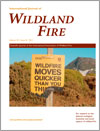International Journal of Wildland Fire
Volume 20
Number 8 2011
Wildfires result in significant loss of property and life. Current techniques do not allow managers to understand the reduction of risk provided by various fire management practices. Here, we present a method for a holistic analysis of fire management strategies. The technique will allow the consideration of management costs in the future.
We test a model of wildfire mitigation by homeowners that includes perceived risk, perception of threat significance and the influence of perceived costs and benefits of mitigation. We found that perceived threat had the greatest effect on mitigation followed by perceived effectiveness of mitigation, and not having financial resources.
Prescribed burns were carried out in areas where shrubs had been masticated under the canopy of young ponderosa pines. Fires exhibited slow rates of spread and moderate flame lengths, with tree mortality associated primarily with crown scorch. Custom fuel models improved the prediction of fire behaviour and effects.
An experimental laboratory study on combustibility of firebrand material of pine cones and scales and pieces of eucalyptus bark is reported. Empirical models to estimate trends of variation of mass loss and combustion duration with particle orientation and flow velocity are proposed to illustrate their relevance in spot fire modelling.
The Canadian Forest Fire Weather Index (FWI) system was evaluated for the Daxing'anling region of northern China to provide a working fire danger rating system to improve fire management in this region.
Triodia sp. nov. is shown to be an obligate seeder in experimental fire plots which control for the removal of adult plants. Germination is strongly induced by fire and seedling survival is high during the first dry season. A small number of plants reach reproductive maturity in the first season.
This paper develops a series of spatially explicit models for prioritising fuel reduction treatments. Post-fire burn severity, surface cover and surface erosion were predicted for most of the forested areas in the western United States. A sensitivity analysis also was conducted, and the procedures and results can be adapted and applied to other areas.
This short note considers the performance of a very simple model for estimating the moisture content of eucalypt litter compared with that of a complex process-based model and two of its simplifications. The comparison is based on observational data in the absence of rainfall and condensation.




